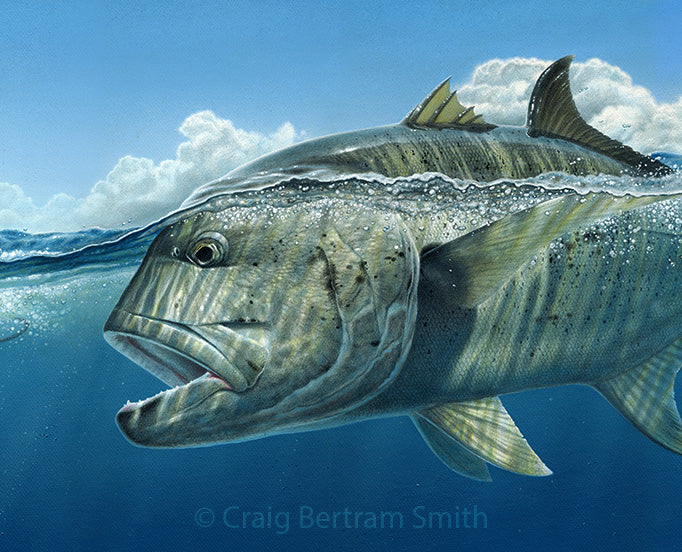
Project GT

The latest GT project was quite a journey. It all started, as it begins in all my paintings, research and gathering as much reference as possible. But I needed something more specific this time around and I knew it was going to be near impossible to find it.
I wanted to intensify my efforts in accurately translating the split second moment of the predator chase. There is much detail at the point of attack that is impossible to capture in real life, so I needed to create a controlled environment to simulate and capture the action. A physical fish to model underwater would be ideal to allow me to record the exact lighting and angels essential for the required reference. Short of catching a GT, an impossibility considering my current geographical location. I realized I needed a replica so I decided to sculpt a small kingfish and paint it with the necessary detail for a life-like representation. It had to be water proof and was sealed with a few coats of epoxy resin.
With the model ready to be submerged, the camera was set to hi speed multi-shot as it captured the GT from different angels. The result was quite convincing and I was able to gather very useful pictures showing the effect of lighting underwater.
Moulding the details - the fins posed the greatest challenge, too thin they would just break off, so I had to compromise as the pectoral fins were never going to work with clay, so mouldable plastic, I thought, would give me the best solution. the flexible plastic also resulted in a somewhat translucent fin which is quite realistic as light is able to penetrate through. I inserted magnets to allow detachment and movement. Once the model has a few layers of eposy applied the overall strength of the fins are greatly improved.

Painted and sealed with epoxy resin, the little model is ready to take a swim!

I was able to position the model at optimal angles to best display the rippling light over the surface of the model
The next step was mentally choreographing the reference to form a concept in a preliminary sketch. The drawing would form the blue print for the final stage of painting.

The water surface turbulence posed a bit of a challenge as I had to play around with different options to see what would look more correct. Adding bubbles was also carefully considered, as I didn't want to loose too much detail in the fish and at the same time ensuring that the desired action would translated to the viewer. With the painting completed I am pleased with the result and I now look forward to starting the next project!


11 comments
Hi Craig,
I am so impressed with the work you are doing! I am a sculptor and have been commissioned to do a sculpture of a Musselcracker of 1.2m long. I have enlarged a photo and so I can get the size correct but I have no idea what the dimensions around the girth would be. Can you perhaps help in any way?
uiMBoVTfmb
slXCvFWLctRMb
pNdKyohUMglfYQ
QjaeHdotI